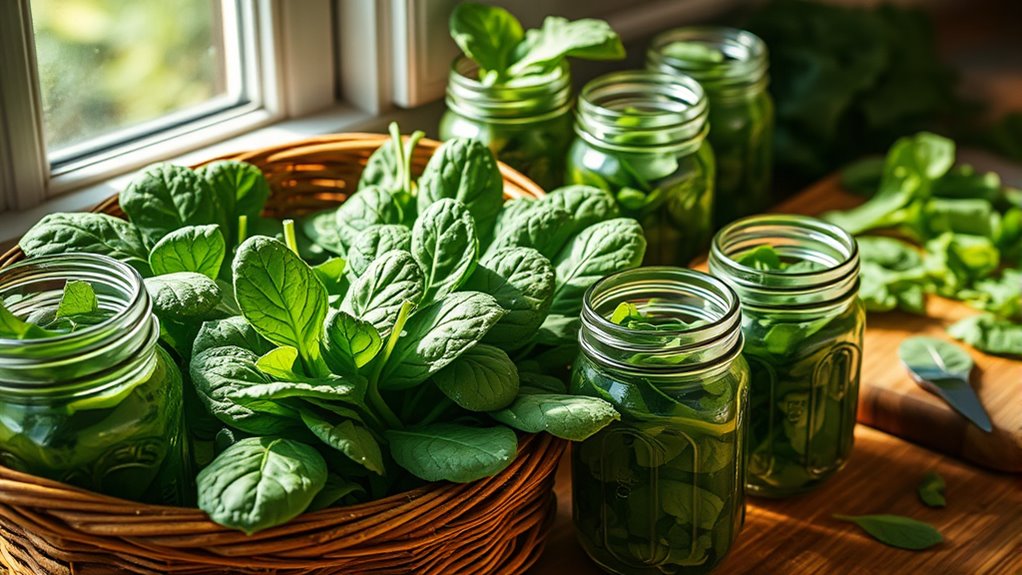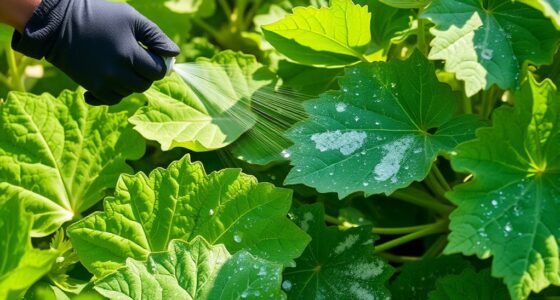To store spinach for months, freezing is your best option. First, ensure the spinach is dry and unwashed, then pack it into Ziploc bags, removing as much air as possible before sealing. For easier use, puree the spinach with a bit of water and freeze in ice cube trays. This way, you can enjoy nutrient-rich spinach anytime. Plus, there are more techniques to keep your spinach fresh, so keep exploring for all the best tips!
Key Takeaways
- Freeze fresh spinach in Ziploc bags, removing air to prevent freezer burn, for up to a year.
- Puree spinach with water and freeze in ice cube trays for easy portioning.
- Store unwashed, dry spinach in breathable containers to prolong freshness before freezing.
- Line storage containers with paper towels to absorb moisture and prevent spoilage.
- Regularly check for spoiled leaves and remove them to maintain the quality of stored spinach.
Understanding Spinach Shelf Life
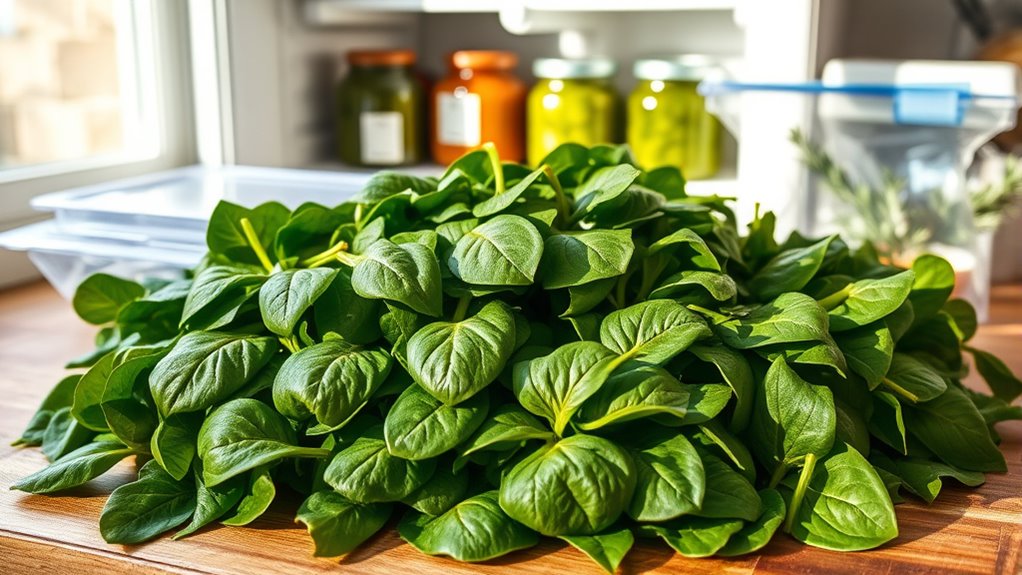
When you understand spinach's shelf life, you can make the most of this nutritious green. Several factors influence how long your spinach stays fresh.
Temperature is crucial; keeping it consistently cold helps prevent decay. Moderate humidity is key to avoiding sogginess, so store it in the crisper drawer.
Packaging matters too—using breathable containers can protect against air and moisture. Remember, how you handle spinach also affects its longevity; whole leaves last longer than chopped or cooked options.
Whole spinach can last 5-7 days unopened, while chopped raw spinach only lasts 1-2 days. Regularly check for spoilage signs like sliminess, and remove any spoiled leaves to keep the rest fresh longer.
Choosing Fresh Spinach for Longevity
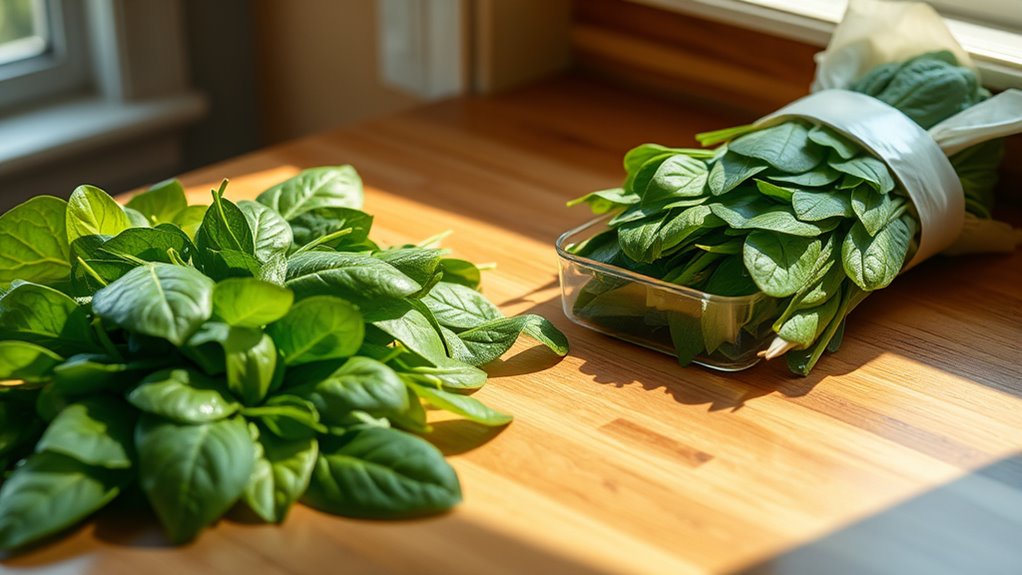
Selecting fresh spinach is key to maximizing its longevity and nutritional benefits. When you shop, look for vibrant green leaves that are perky and free from any yellowing or wilting. Avoid spinach with visible damage, as this can lead to spoilage.
It's best to buy spinach close to when you'll use it, ensuring freshness. Handle it with care and store it in breathable containers to prevent moisture buildup; excess moisture can lead to decay.
Keep your spinach in the refrigerator's crisper drawer, away from direct sunlight and heat. Remember, don't wash it before storage unless absolutely necessary.
Following these tips will help maintain the nutrients and flavor of your spinach for as long as possible.
Effective Methods for Extending Freshness
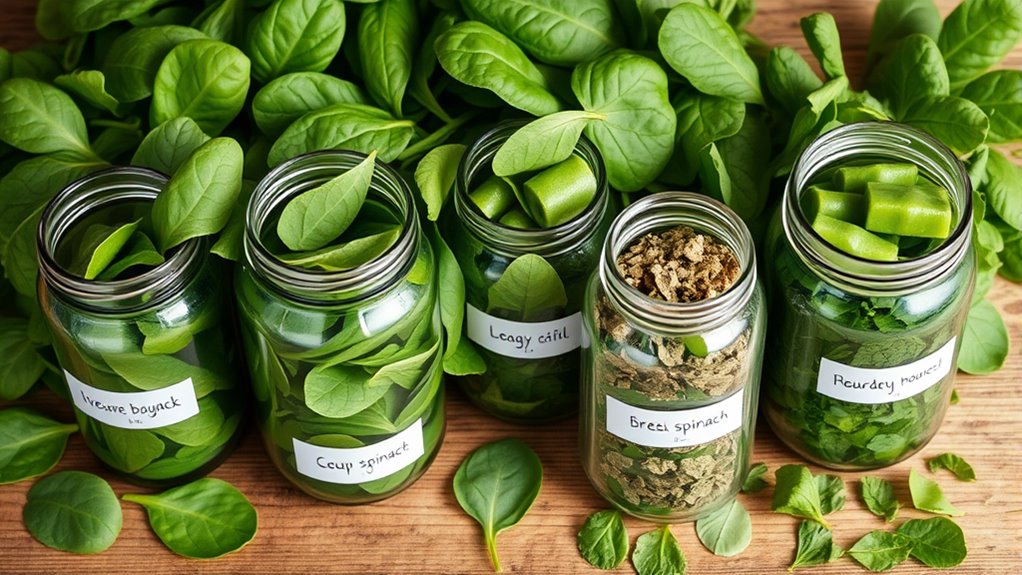
To keep your spinach fresh for as long as possible, focus on effective storage techniques that minimize moisture and maintain optimal conditions.
First, use breathable containers with ventilation holes to enhance airflow and prevent moisture buildup. Store your spinach in the crisper drawer where the humidity is higher, but ensure it's unwashed and dry.
Use breathable containers to improve airflow and keep spinach unwashed and dry in the crisper drawer for optimal freshness.
Line containers with paper towels to absorb excess moisture and avoid overcrowding the leaves. Keep your spinach in the coolest part of the fridge and away from direct light.
Regularly check for condensation, and remove any spoiled leaves to prevent spreading. By managing moisture levels and maintaining the right environment, you can significantly extend the freshness of your spinach.
Freezing Spinach for Long-Term Storage

Freezing spinach is a fantastic way to preserve its freshness and nutrients, ensuring you have this versatile ingredient on hand for months to come.
You can freeze spinach without blanching if you plan to use it within six months. Simply place fresh, dry spinach leaves in a Ziploc bag, remove the air, and freeze.
For added convenience, consider pureeing spinach with a bit of water and freezing it in ice cube trays. This method makes it easy to toss into smoothies or recipes.
Remember, frozen spinach can last up to a year, making it a cost-effective choice that reduces waste and keeps your meals nutritious year-round.
Enjoy the flexibility of having spinach ready whenever you need it!
Tips for Maintaining Spinach Freshness
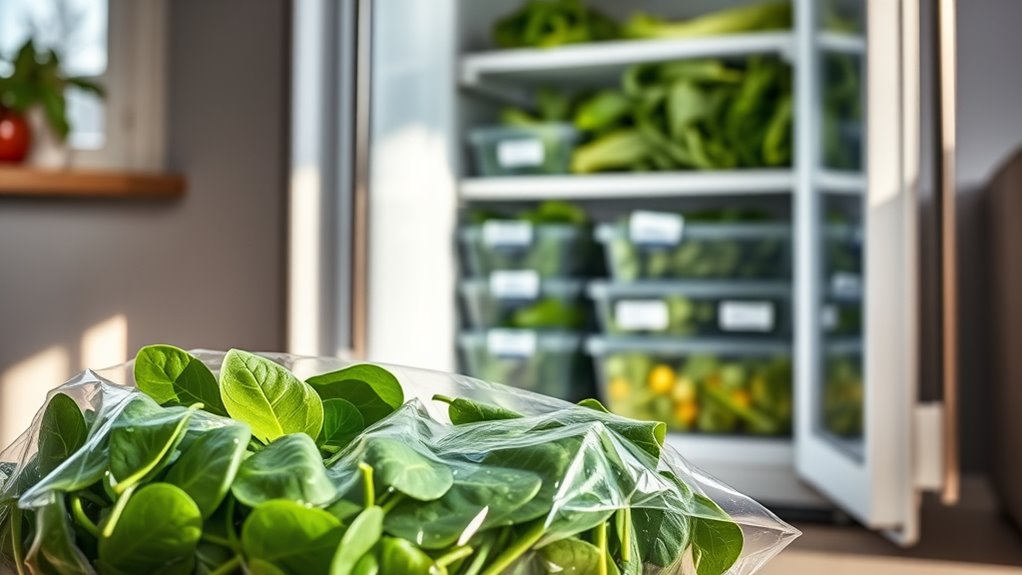
After you've frozen spinach for long-term storage, it's important to know how to keep fresh spinach at its best when it's not frozen.
First, store unwashed spinach to prevent excess moisture, which leads to wilting. Use breathable containers or perforated bags to allow airflow and moisture release. You can also place dry paper towels inside the container to absorb any moisture.
Always check for quality—remove any wilted or discolored leaves before storing. Keep spinach in the crisper drawer of your refrigerator, away from strong-smelling foods and ethylene-producing fruits.
Finally, maintain your fridge temperature between 32°F and 40°F, and regularly inspect the spinach to catch any spoilage early.
Innovative Storage Solutions for Spinach
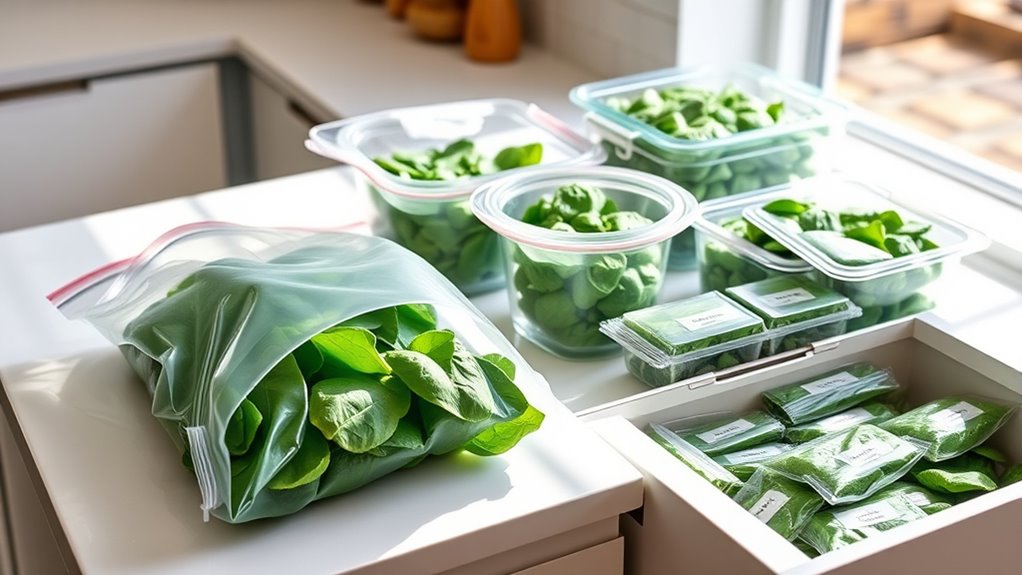
While traditional methods of storing spinach can be effective, exploring innovative storage solutions can significantly enhance its freshness and longevity.
Consider using Modified Atmosphere Packaging (MAP) to maintain optimal oxygen levels, or try BreatheWay Technology, which reduces decay by creating a beneficial atmosphere.
Breathable containers with ventilation holes promote airflow, while produce keepers control moisture effectively. For extra moisture absorption, place paper towels in your containers.
In your refrigerator, use the crisper drawer to maintain consistent temperatures and humidity.
Blanching and freezing spinach can extend its shelf life up to six months. Additionally, incorporating essential oils for respiratory health can help maintain a pleasant environment while storing leafy greens.
Lastly, avoid pre-washing to prevent excess moisture; wash just before use for the best results.
These strategies will keep your spinach fresher for longer!
Creative Ways to Revive Wilting Spinach
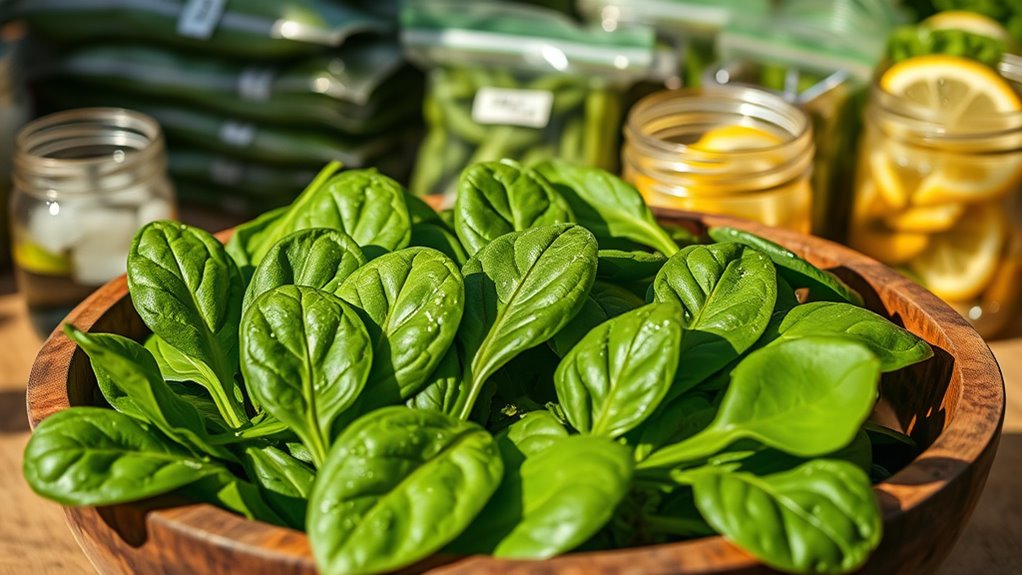
If you find your spinach wilting and losing its crispness, don't worry—there are several effective methods to revive it.
Start by submerging the leaves in ice-cold water for 15 to 30 minutes. For an extra boost, mix in a little salt; this saline solution helps draw moisture back into the leaves.
After soaking, dry the spinach thoroughly with towels or a salad spinner to avoid sogginess. If you're working with delicate greens, cut the stems before soaking to enhance absorption.
Remember, storing revived spinach in breathable containers will keep it fresh longer.
Frequently Asked Questions
Can I Store Spinach at Room Temperature?
You can't store spinach at room temperature for long without it spoiling. It deteriorates quickly due to high metabolic activity, losing nutrients and becoming unappetizing.
Even if it looks fresh, the quality drops fast, increasing the risk of bacterial growth.
To keep your spinach fresh, it's best to refrigerate it at around 32°F (0°C) or freeze it for longer storage. This way, you'll maintain its nutritional value and flavor.
How Do I Identify Spoiled Spinach?
Imagine biting into a wilted leaf instead of fresh, vibrant greens—that's how you'll know spinach has gone bad.
To identify spoiled spinach, look for yellow, brown, or black leaves. Check for slimy texture; it shouldn't feel soggy. If it smells sour or musty, toss it out.
Excess moisture leads to wilting, so keep an eye on that, too. Regular inspections help you catch any bad leaves before they spoil the whole bunch.
Can I Mix Spinach With Other Vegetables for Storage?
Yes, you can mix spinach with other vegetables for storage, but be cautious.
Make sure the vegetables have similar moisture levels and storage needs. High-moisture veggies should be stored separately to prevent spoilage.
Also, keep an eye on ethylene-producing vegetables, as they can cause spinach to spoil faster.
To maintain freshness, ensure all vegetables are stored in breathable containers and at consistent refrigeration temperatures.
This way, you'll enjoy a variety of flavors and nutrients!
Is It Safe to Eat Spinach After Its Expiration Date?
Imagine a wilted leaf, once vibrant, now fading. Eating spinach after its expiration date isn't the best idea.
While it might seem okay at first glance, it can harbor bacteria that lead to food poisoning. Always inspect for yellowing or sliminess, and trust your nose—if it smells off, toss it.
To play it safe, stick to fresh spinach to enjoy its health benefits without the risk of spoilage.
Can I Grow Spinach From Leftover Stems?
Yes, you can grow spinach from leftover stems! Just ensure the stems have intact roots. Cut the tops for cooking, leaving the roots for planting.
Use well-draining soil and provide consistent moisture. Spinach thrives in cool temperatures and needs partial shade to full sun.
Regularly harvesting encourages new leaf growth, so keep planting new batches every few weeks for a continuous supply. Enjoy your fresh spinach right from your garden!
Conclusion
In the dance between freshness and preservation, mastering the art of spinach storage allows you to savor its vibrant taste long after harvest. While fresh leaves wilt and fade, your clever techniques can transform them into a nourishing staple that endures. Whether you freeze, innovate, or simply maintain, you hold the power to embrace both immediacy and longevity. So, go ahead—cultivate your culinary skills and enjoy spinach's bounty, no matter the season.

